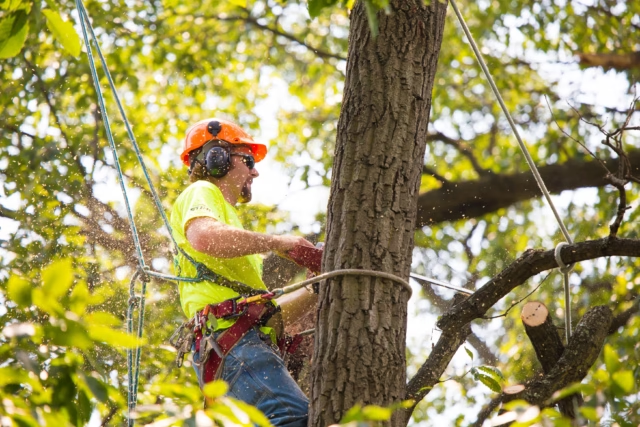Trees add beauty, shade, and value to any property. But just like anything else in your landscape, trees need regular care to stay healthy and safe. One of the most important parts of tree care is trimming. But how do you know when it’s time? Trimming at the right time keeps trees strong, improves their shape, and prevents potential hazards. In this blog, we’ll break down the clear signs that your tree may need a trim — all in simple, easy-to-understand terms.
1. Dead or Broken Branches
One of the most obvious signs that your tree needs trimming is the presence of dead, dying, or broken branches. These limbs not only affect the look of the tree but can also be dangerous. During storms or strong winds, these branches can fall and cause damage to property or injury to people. If you see branches that snap easily or have no leaves during the growing season, it’s time to consider trimming them.
2. Tree Looks Uneven or Overgrown
An overgrown tree may start to look lopsided, with branches growing more heavily on one side. This can cause weight imbalance, making the tree more likely to lean or fall over time. Overgrown trees can also block sunlight from reaching other plants or parts of your lawn. Regular trimming helps maintain the shape and health of the tree while improving overall yard appearance.
3. Branches Touching Roofs, Power Lines, or Structures
If tree branches are growing close to your home, roof, windows, power lines, or other buildings, that’s a clear sign that trimming is needed. These branches can cause serious damage during storms and might even allow pests to enter your home. Keeping your tree trimmed away from structures is essential for both safety and home maintenance.
Looking for help with this? Many homeowners rely on Tree Trimming Services in Myrtle Beach, SC to handle these risky situations properly. Professionals have the tools and experience to safely trim trees around homes and utility lines.
4. Too Much Shade or Limited Airflow
While trees provide great shade, too much of it can harm grass and smaller plants under the tree. A thick canopy may block airflow and light, creating damp conditions that encourage pests and fungi. Thinning out the branches through proper trimming can improve light and air circulation, which helps the entire landscape thrive.
5. Storm Damage or Sudden Drooping
After a storm, always check your trees. Heavy winds and rain can cause hidden damage that isn’t obvious at first. If a branch looks like it’s sagging or cracked, trimming it early can stop bigger problems later. Similarly, if you notice a branch suddenly drooping or leaning, it might be time for a closer look and possible trimming.
6. Signs of Disease or Pests
Certain signs like unusual leaf discoloration, holes in the bark, fungi growth, or odd patterns in the wood can mean disease or pest issues. Trimming infected or damaged limbs can stop the spread and save the rest of the tree. Early detection and action are key to protecting your trees from further harm.
As many local property owners have found, working with a knowledgeable and reliable service makes a big difference. Sprouse’s Landscaping Inc. has earned a strong reputation in the region for their detailed and thoughtful approach to tree care. Homeowners often mention their team’s professionalism and skill, especially when it comes to safe, efficient trimming that improves tree health while protecting the surrounding property.
7. Trees Blocking Views or Driveways
Trees growing too tall or wide may block your view of the street or create blind spots in your driveway. In some cases, branches may hang low enough to scrape cars or get in the way of pedestrians. If a tree is becoming more of an obstacle than an asset, it’s time for a trim.
8. Tree Growth Looks Unnatural
Have you noticed strange growth patterns like branches crossing each other, growing downward, or shooting straight up? These patterns can weaken the tree and lead to long-term issues. Trimming helps guide healthy growth and strengthens the overall structure of the tree, making it more resistant to storms and disease.
9. Seasonal Maintenance and Routine Care
Even if your tree looks healthy, trimming is a part of seasonal maintenance. Trees benefit from regular care every 1–3 years depending on species, age, and location. Routine trimming keeps them strong and attractive while reducing the chance of problems later. It also makes it easier to detect early signs of stress or damage.
Conclusion
Trees are an important part of your property, but they need proper care to grow strong and stay safe. Dead limbs, overgrowth, signs of disease, and risky placement near structures are all clear signs your tree may need trimming. Regular maintenance not only keeps your landscape looking beautiful but also prevents costly damage and extends the life of your trees.
Whether you’re noticing one of the signs above or just want peace of mind, it’s always a good idea to consult with professionals. Trimming is more than just cutting branches — it’s about knowing what to cut, when, and how. That’s where expert help becomes valuable. Take care of your trees now, and they’ll keep your property shaded, strong, and safe for years to come.







